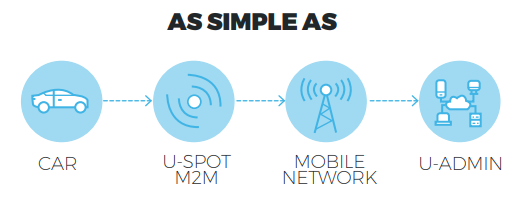Urbiotica a annoncé le lancement de son nouveau capteur de stationnement U-SPOT. M2M lors de la dernière édition d’Intertraffic. En conséquence, l’entreprise indique que plus de 2 000 unités du nouveau capteur de détection carré à carré M2M sont prêtes à être installées dans 3 villes espagnoles d’ici la fin du premier trimestre 2020.
Grâce à la nouvelle norme 3GPP NB-IoT, le nouveau U-Spot M2M communique avec la plateforme U-Admin directement sur le réseau de télécommunications mobiles grâce à une carte SIM intégrée au capteur. Comme il n’est pas nécessaire de déployer une infrastructure de communication supplémentaire, le coût de la solution a été considérablement réduit pour les applications dispersées et les pays où l’infrastructure électrique et d’éclairage de la ville ne peut pas être utilisée pour soutenir le déploiement de passerelles IoT.

Grâce à une amélioration majeure de l’optimisation de l’énergie utilisée dans le nouveau capteur, celui-ci est capable d’atteindre une durée de vie de 10 ans dans des conditions normales d’utilisation et une qualité de couverture de réseau mobile standard. En outre, l’algorithme U-Spot a été conçu pour garantir une fiabilité de détection de 98 % pendant la durée de vie du capteur, tout en minimisant les coûts de communication associés.
En outre, Urbiotica a conclu des accords avec deux grands opérateurs de télécommunications pour offrir à ses clients une solution de bout en bout, y compris la connectivité pour un premier paquet de 7 pays européens. Des accords d’itinérance inter-opérateurs pour le protocole NB-IoT étendront bientôt la zone d’influence du système.
Le premier déploiement de masse prévu aura lieu dans la ville d’Utrera (Séville), avec 700 capteurs M2M U-Spot dans le centre-ville. Le projet, intégré par Telefónica, vise à faciliter la recherche de places de stationnement libres dans la zone grâce à une application mobile gratuite à l’usage des citoyens.
Castellón et Murcia seront également équipées du nouveau capteur au cours du premier trimestre 2020, afin de disposer d’une solution technologique complète pour contrôler l’utilisation des places de stationnement réservées aux personnes à mobilité réduite, le chargement et le déchargement, ainsi que l’utilisation des véhicules électriques.
Autres liens intéressants :